A Heterogeneous Network Modeling Method Based on Public Goods Game Theory to Explore Cooperative Behavior in VANETs
Abstract
1. Introduction
- We take the attributes of nodes into consideration and then model VANET as a heterogeneous network containing nodes with rational and altruistic attributes. The previous works normally assumed that vehicles in the system are rational, i.e., each one aims to obtain more benefits through neighborhood interaction. However, many facts have proved that altruism is also an important internal attribute. When vehicles are communicating with each other, they will consider many external environment factors. Ignoring such an attribute of vehicles may lead to oversimplified or misleading conclusions [11].
- We introduce Other-regarding Preference (ORP) and fitness factor into PGG-based VANET model to more realistically characterize the altruism and consider the neighborhood in the assessment of nodes. Among the many external environmental factors, taking neighborhood benefits into consideration is the most common one. While making a strategy, they will consider not only their own benefits, but also the benefits of their neighbors.
- We define some city-owned infrastructures as zealots that always maintain a cooperative strategy in case of requests from neighborhoods. The previous works were mainly constructed on the communication of vehicle-to-vehicle (V2V). However, some transport infrastructures can also collect information from the surroundings and exchange this information in real time with other nearby entities. Unlike vehicles, infrastructure components such as RSUs usually have rich bandwidth, powerful computing capabilities, and abundant local storage. Therefore, these infrastructures can be regarded as a new type of node in heterogeneous vehicle networking.
- We construct an urban traffic road model and then evaluate the impacts of the different attributes on the cooperation under different network conditions. The introduction of altruistic nodes and zealots can significantly improve the proportion of cooperators, and the network can maintain a high level of cooperator proportion even under adverse conditions.
2. Related Works
3. Proposed Model
3.1. Packet Forwarding Game in VANET
3.2. Dynamic Altruism Public Goods Game in VANET
| Algorithm 1: DAPGG Algorithm |
 |
3.3. Stubborn Decision-Makers in DAPGG
3.4. Communication in DAPGG
3.5. Evolution of Strategy
| Algorithm 2: Strategy Update Algorithm |
 |
3.6. Mobility in DAPGG
4. Simulation
4.1. Experiment Settings
4.2. Altruistic Nodes in DAPGG
4.2.1. The Impact of Simulation Numbers
4.2.2. The Impact of Synergy factor
4.2.3. The Impact of Altruistic Node Proportion
4.2.4. The Impact of Fitness Factor
4.3. Zealots in DAPGG
4.3.1. The Impact of Zealots Number
4.3.2. The Impact of Vehicle Number
4.3.3. The Impact of Altruistic Node Proportion
4.3.4. The Impact of Fitness Factor
5. Conclusions
Author Contributions
Funding
Conflicts of Interest
References
- Lee, U.; Magistretti, E.; Gerla, M.; Bellavista, P.; Corradi, A. Dissemination and harvesting of urban data using vehicular sensing platforms. IEEE Trans. Veh. Technol. 2008, 58, 882–901. [Google Scholar]
- Lee, U.; Zhou, B.; Gerla, M.; Magistretti, E.; Bellavista, P.; Corradi, A. Mobeyes: Smart mobs for urban monitoring with a vehicular sensor network. IEEE Wirel. Commun. 2006, 13, 52–57. [Google Scholar] [CrossRef]
- Shivshankar, S.; Jamalipour, A. An evolutionary game theory-based approach to cooperation in vanets under different network conditions. IEEE Trans. Veh. Technol. 2014, 64, 2015–2022. [Google Scholar] [CrossRef]
- Ding, Q.; Zeng, X.; Zhang, X.; Sung, D.K. A public goods game theory-based approach to cooperation in VANETs under a high vehicle density condition. IEEE Trans. Intell. Transp. Syst. 2018, 20, 3995–4005. [Google Scholar] [CrossRef]
- Srinivasan, V.; Nuggehalli, P.; Chiasserini, C.F.; Rao, R.R. Cooperation in wireless ad hoc networks. In Proceedings of the IEEE INFOCOM 2003. Twenty-Second Annual Joint Conference of the IEEE Computer and Communications Societies (IEEE Cat. No. 03CH37428), San Francisco, CA, USA, 30 March–3 April 2003; pp. 808–817. [Google Scholar]
- Chen, B.B.; Chan, M.C. Mobicent: A credit-based incentive system for disruption tolerant network. In Proceedings of the 2010 IEEE INFOCOM, San Diego, CA, USA, 14–19 March 2010; pp. 1–9. [Google Scholar]
- Ng, S.K.; Seah, W.K. Game-theoretic approach for improving cooperation in wireless multihop networks. IEEE Trans. Syst. Man. Cybern. Part B (Cybernetics) 2010, 40, 559–574. [Google Scholar]
- Krishnan, R.; Smith, M.D.; Tang, Z.; Telang, R. The impact of free-riding on peer-to-peer networks. In Proceedings of the 37th Annual Hawaii International Conference on System Sciences, Big Island, HI, USA, 5–8 January 2004. [Google Scholar] [CrossRef]
- Banerjee, A.; Gauthier, V.; Labiod, H.; Afifi, H. Cooperation optimized design for information dissemination in vehicular networks using evolutionary game theory. arXiv Preprint 2013, arXiv:1301.1268. [Google Scholar]
- Sun, Y.; Yu, Y.; Han, J. Ranking-based clustering of heterogeneous information networks with star network schema. In Proceedings of the 15th ACM SIGKDD International Conference on Knowledge Discovery and Data Mining, Paris, France, 28 June 2009; pp. 797–806. [Google Scholar] [CrossRef]
- Vassilakis, D.K.; Vassalos, V. An analysis of peer-to-peer networks with altruistic peers. Peer-to-Peer Netw. Appl. 2009, 2, 109–127. [Google Scholar] [CrossRef]
- Li, F.; Wu, J. Frame: An innovative incentive scheme in vehicular networks. In Proceedings of the 2009 IEEE International Conference on Communications, Dresden, Germany, 14–18 June 2009; pp. 1–6. [Google Scholar]
- Chen, Y.; Weng, S.; Guo, W.; Xiong, N. A game theory algorithm for intra-cluster data aggregation in a vehicular ad hoc network. Sensors 2016, 16, 245. [Google Scholar] [CrossRef]
- Iza-Paredes, C.; Mezher, A.; Aguilar Igartua, M.; Forné, J. Game-theoretical design of an adaptive distributed dissemination protocol for VANETs. Sensors 2018, 18, 294. [Google Scholar] [CrossRef]
- Wu, D.; Liu, H.; Bi, Y.; Zhu, H. Evolutionary game theoretic modeling and repetition of media distributed shared in P2P-based VANET. Int. J. Distrib. Sens. Netw. 2014, 10, 718639. [Google Scholar] [CrossRef]
- Kapade, N. TLC: Trust point load balancing method using coalitional game theory for message forwarding in VANET. In Proceedings of the 2014 IEEE Global Conference on Wireless Computing & Networking (GCWCN), Lonavala, India, 22–24 December 2014; pp. 160–164. [Google Scholar]
- Chen, T.; Wu, L.; Wu, F.; Zhong, S. Stimulating cooperation in vehicular ad hoc networks: A coalitional game theoretic approach. IEEE Trans. Veh. Technol. 2010, 60, 566–579. [Google Scholar] [CrossRef]
- Zhang, L.; Jia, S.; Liu, Z.; Wang, Y.; Liu, Y. Bus-Ads: Bus trajectory-based advertisement distribution in VANETs using coalition formation games. IEEE Syst. J. 2015, 11, 1259–1268. [Google Scholar] [CrossRef]
- Zhang, H.; Shi, D.; Liu, R.; Wang, B. Dynamic allocation of investments promotes cooperation in spatial public goods game. Phys. A Stat. Mech. Appl. 2012, 391, 2617–2622. [Google Scholar] [CrossRef]
- Golle, P.; Leyton-Brown, K.; Mironov, I.; Lillibridge, M. Incentives for sharing in peer-to-peer networks. In Proceedings of the International Workshop on Electronic Commerce, Heidelberg, Germany, 29 October 2001; pp. 75–87. [Google Scholar]
- Chu, Y.; Zhang, H. Considering altruism in peer-to-peer internet streaming broadcast. In Proceedings of the 14th International Workshop on Network and Operating Systems Support for Digital Audio and Video, Cork, Ireland, 16–18 June 2004; pp. 10–15. [Google Scholar] [CrossRef]
- Barrachina, J.; Garrido, P.; Fogue, M.; Martinez, F.J.; Cano, J.C.; Calafate, C.T.; Manzoni, P. Road side unit deployment: A density-based approach. IEEE Intell. Transp. Syst. Mag. 2013, 5, 30–39. [Google Scholar] [CrossRef]
- Szolnoki, A.; Perc, M. Zealots tame oscillations in the spatial rock-paper-scissors game. Phys. Rev. E 2016, 93, 062307. [Google Scholar] [CrossRef] [PubMed]
- Mellor, A.; Mobilia, M.; Zia, R. Heterogeneous out-of-equilibrium nonlinear q-voter model with zealotry. Phys. Rev. E 2017, 95, 012104. [Google Scholar] [CrossRef]
- Khalil, N.; San Miguel, M.; Toral, R. Zealots in the mean-field noisy voter model. Phys. Rev. E 2018, 97, 012310. [Google Scholar] [CrossRef]
- Kenney, J.B. Dedicated short-range communications (DSRC) standards in the United States. Proc. IEEE 2011, 99, 1162–1182. [Google Scholar] [CrossRef]
- Wang, P.; Di, B.; Zhang, H.; Bian, K.; Song, L. Cellular V2X communications in unlicensed spectrum: Harmonious coexistence with VANET in 5G systems. IEEE Trans. Wirel. Commun. 2018, 17, 5212–5224. [Google Scholar] [CrossRef]
- Abboud, K.; Omar, H.A.; Zhuang, W. Interworking of DSRC and cellular network technologies for V2X communications: A survey. IEEE Trans. Veh. Technol. 2016, 65, 9457–9470. [Google Scholar] [CrossRef]
- Rong, Z.; Wu, Z. Effect of the degree correlation in public goods game on scale-free networks. EPL 2009, 87, 30001. [Google Scholar] [CrossRef]
- Treiber, M.; Hennecke, A.; Helbing, D. Congested traffic states in empirical observations and microscopic simulations. Phys. Rev. E 2000, 62, 1805. [Google Scholar] [CrossRef] [PubMed]
- Krajzewicz, D.; Erdmann, J.; Behrisch, M.; Bieker, L. Recent development and applications of SUMO-Simulation of Urban MObility. Int. J. Adv. Syst. Meas. 2012, 5, 128–138. [Google Scholar]
- Avilés, L. Cooperation and non-linear dynamics: An ecological perspective on the evolution of sociality. Evol. Ecol. Res. 1999, 1, 459–477. [Google Scholar]
- Kun, Á.; Boza, G.; Scheuring, I. Asynchronous snowdrift game with synergistic effect as a model of cooperation. Behav. Ecol. 2006, 17, 633–641. [Google Scholar] [CrossRef]
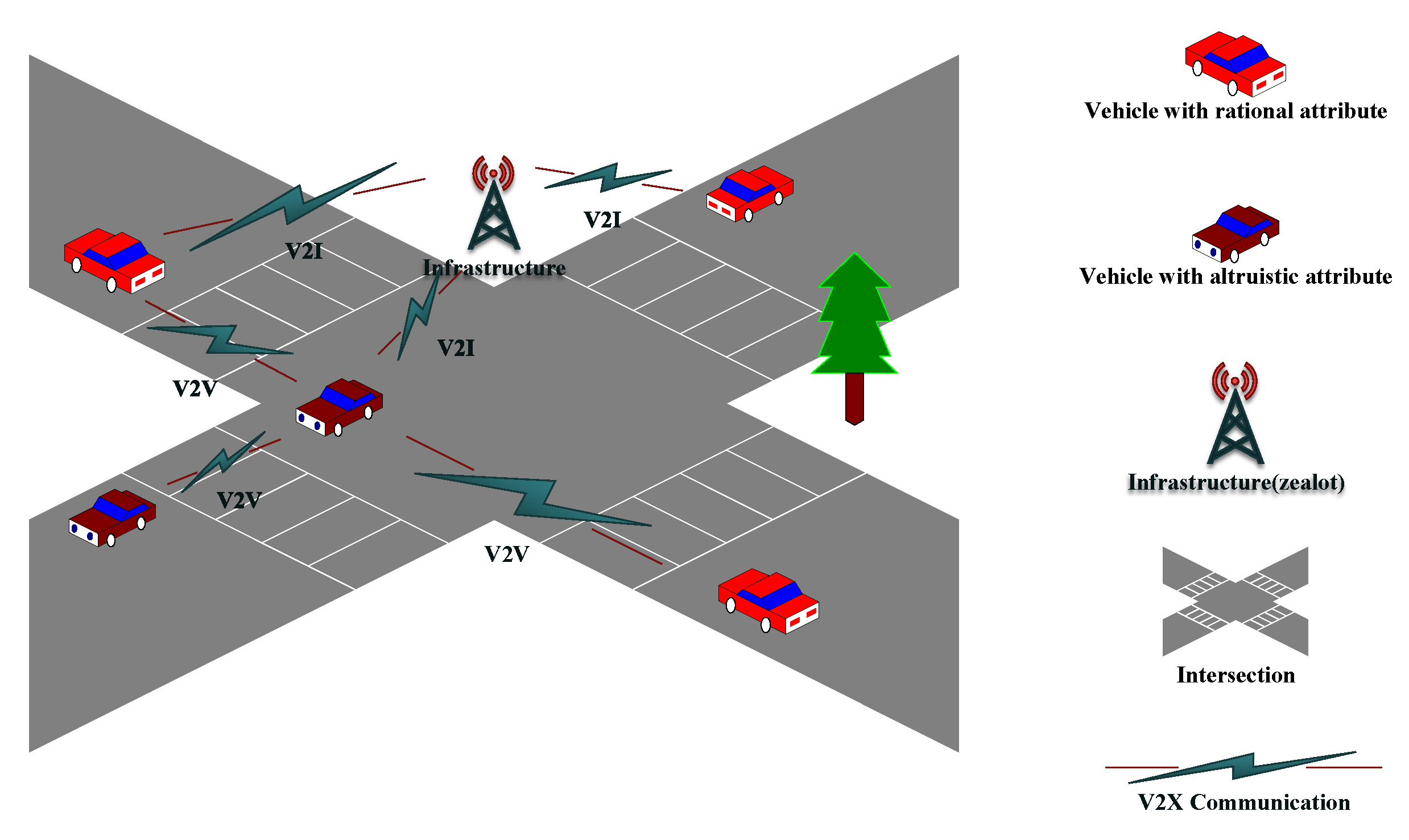
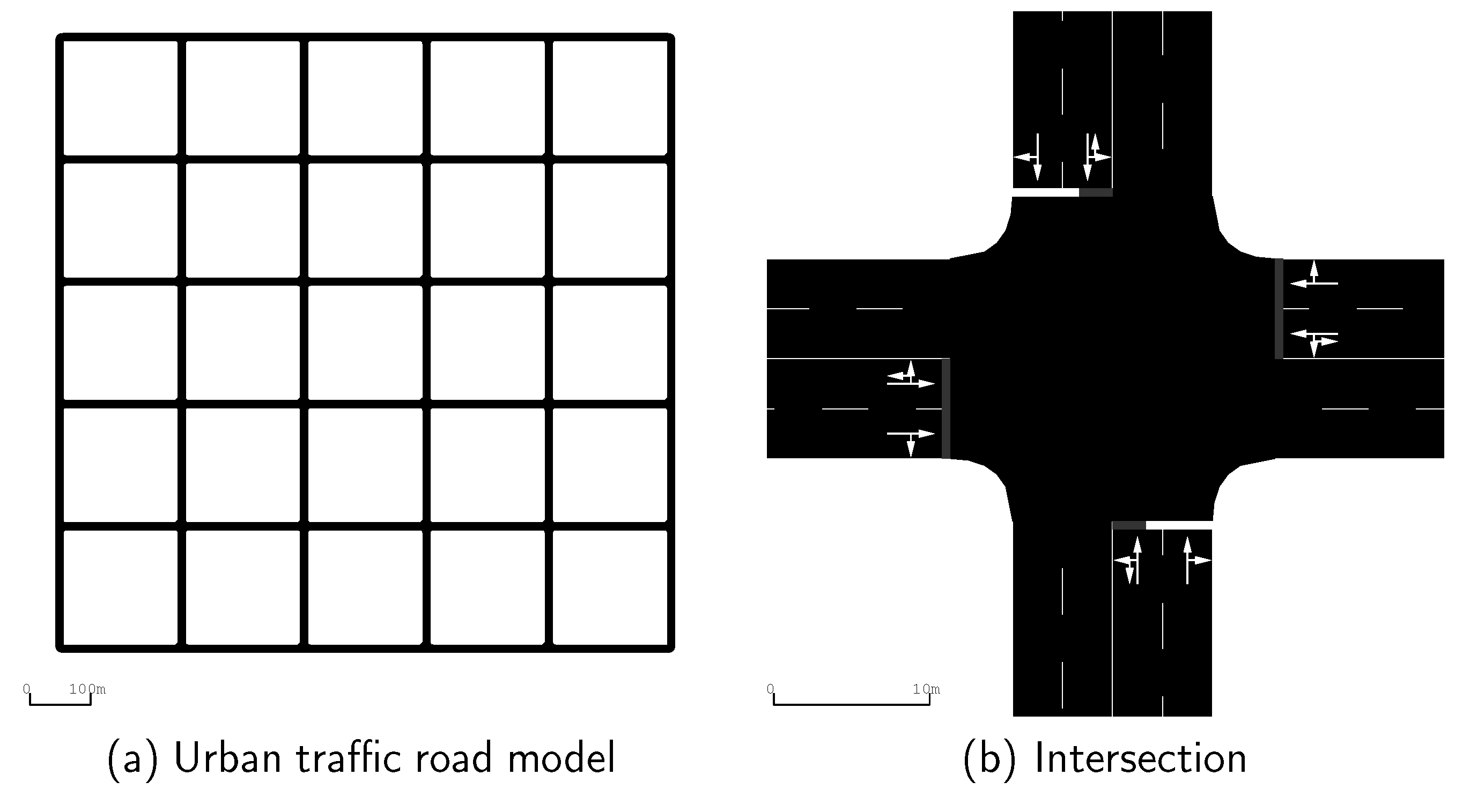

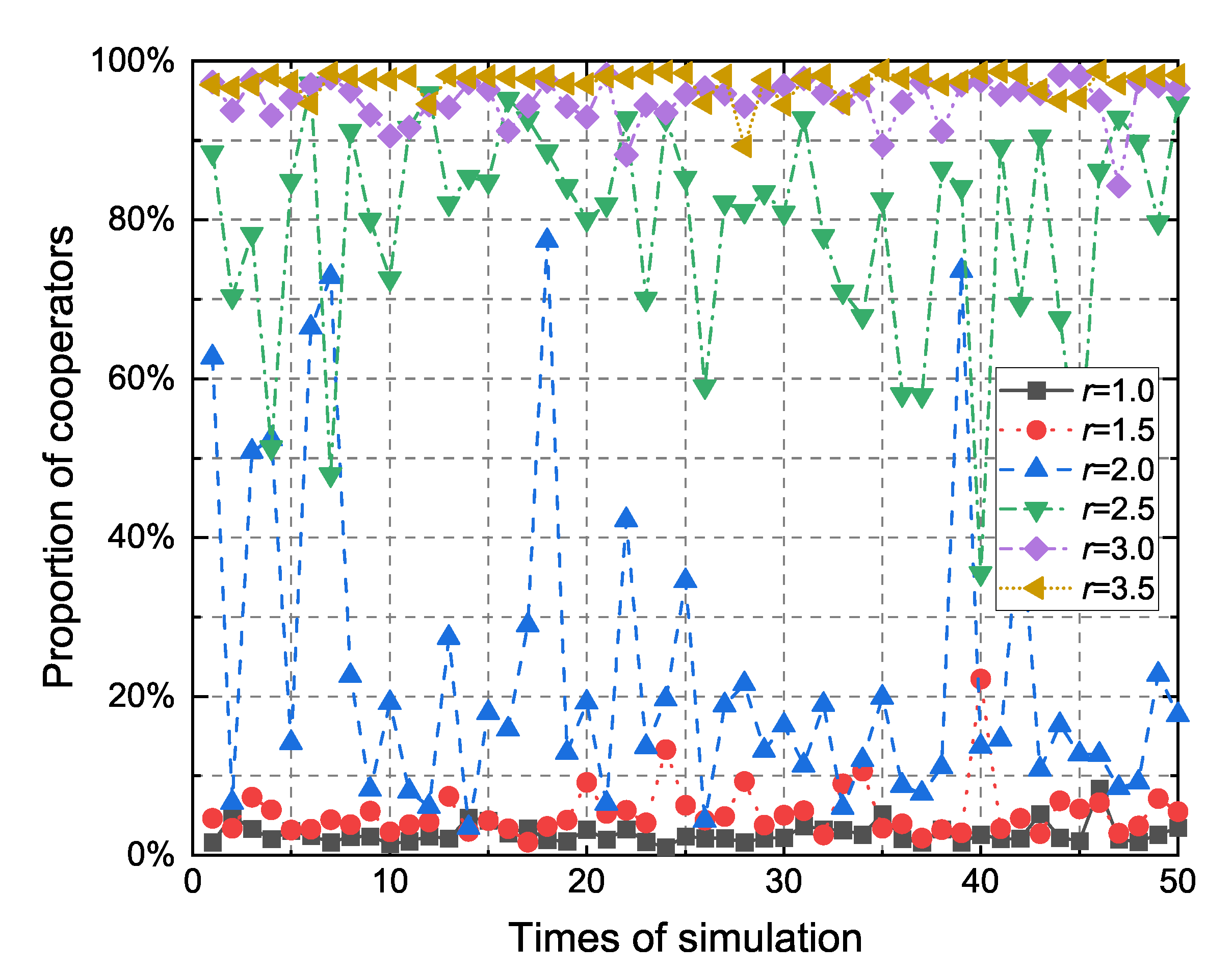
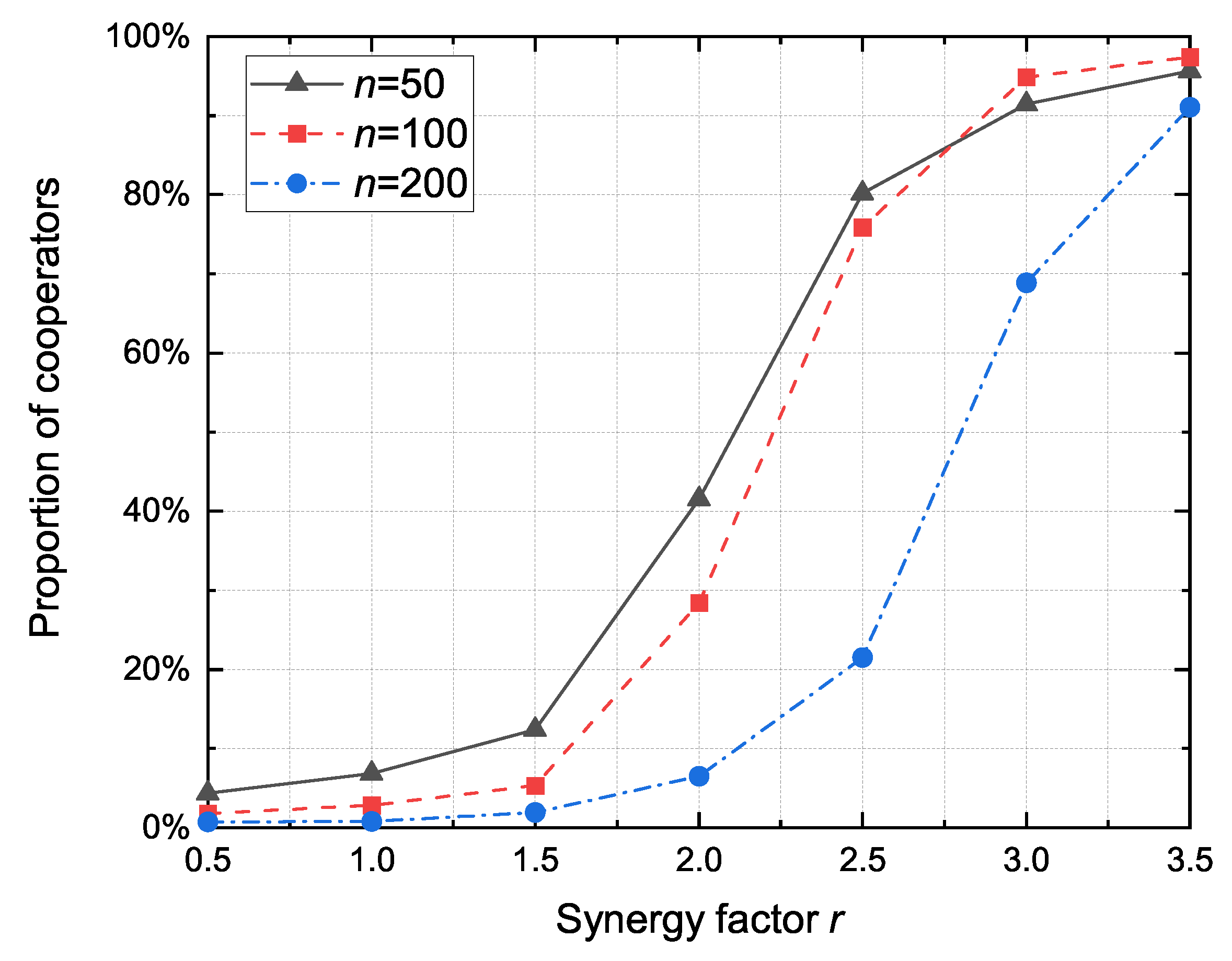
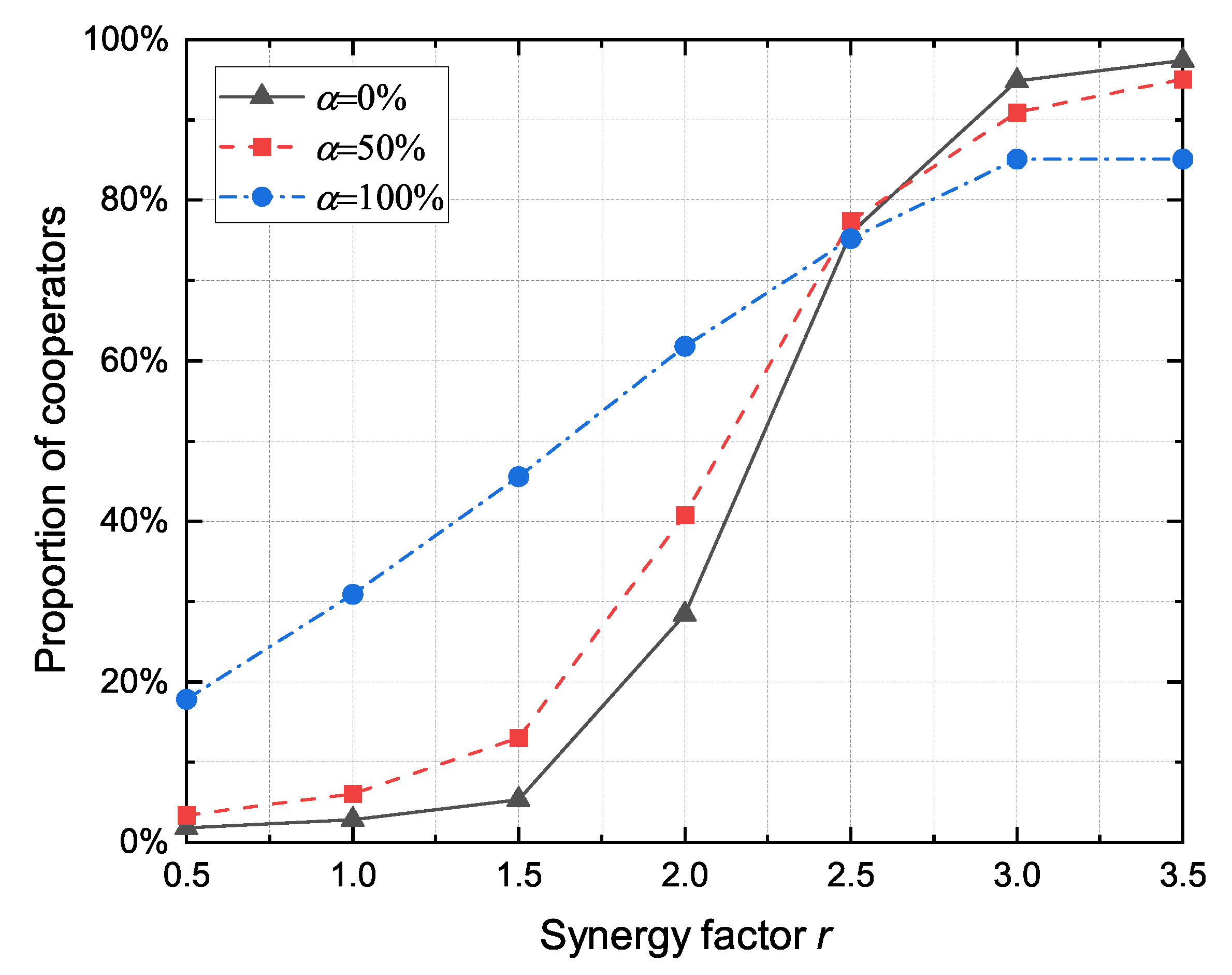
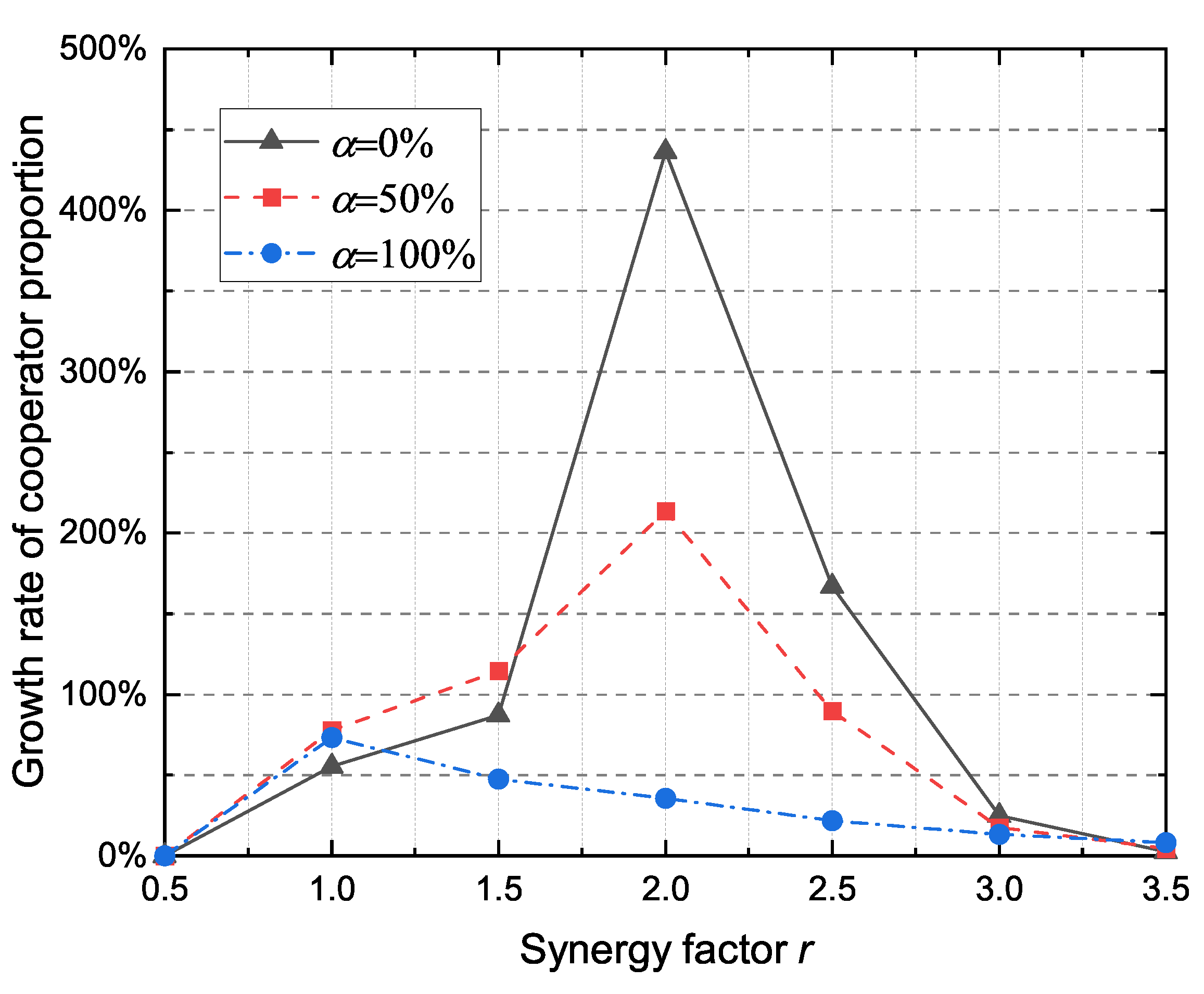
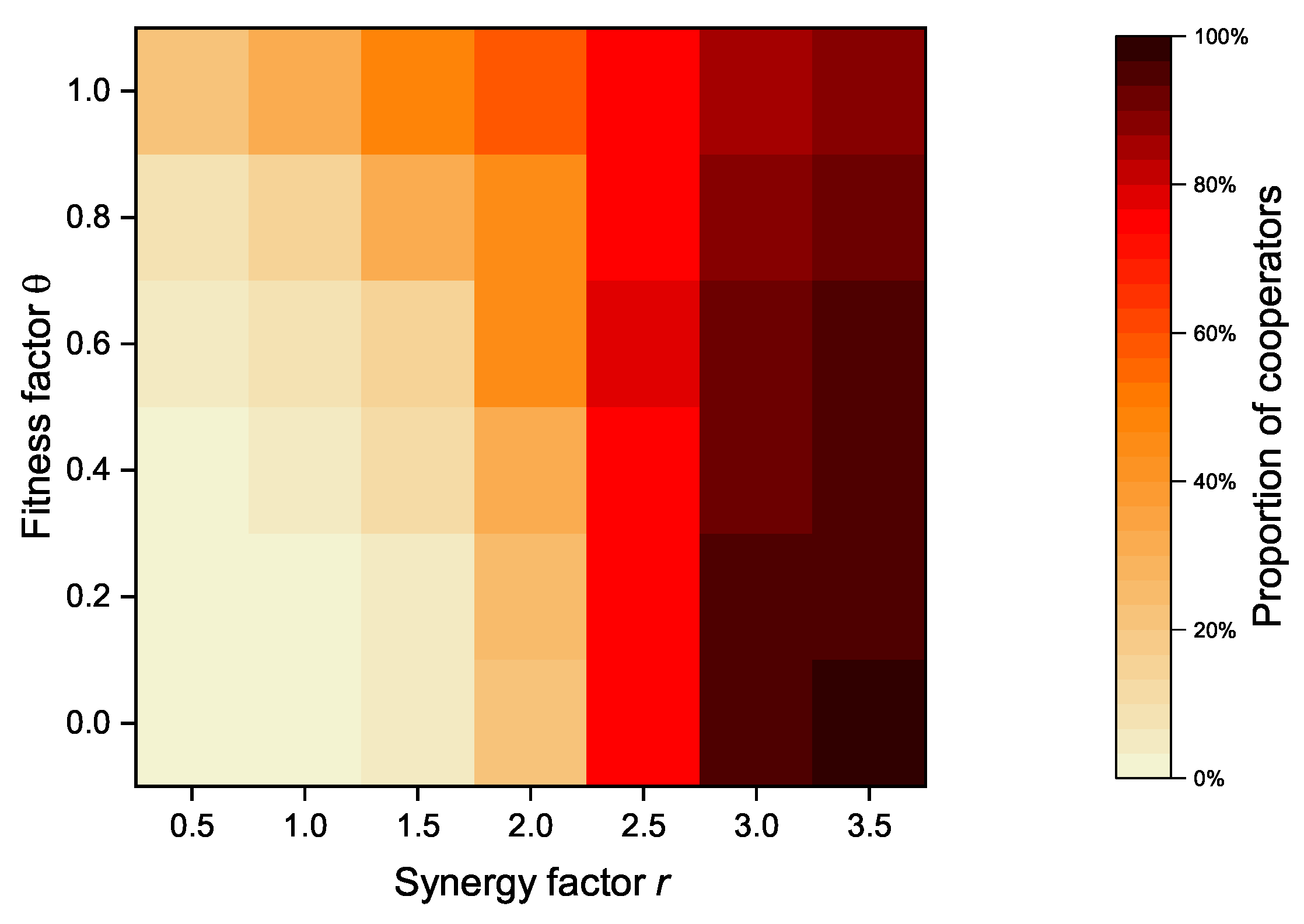
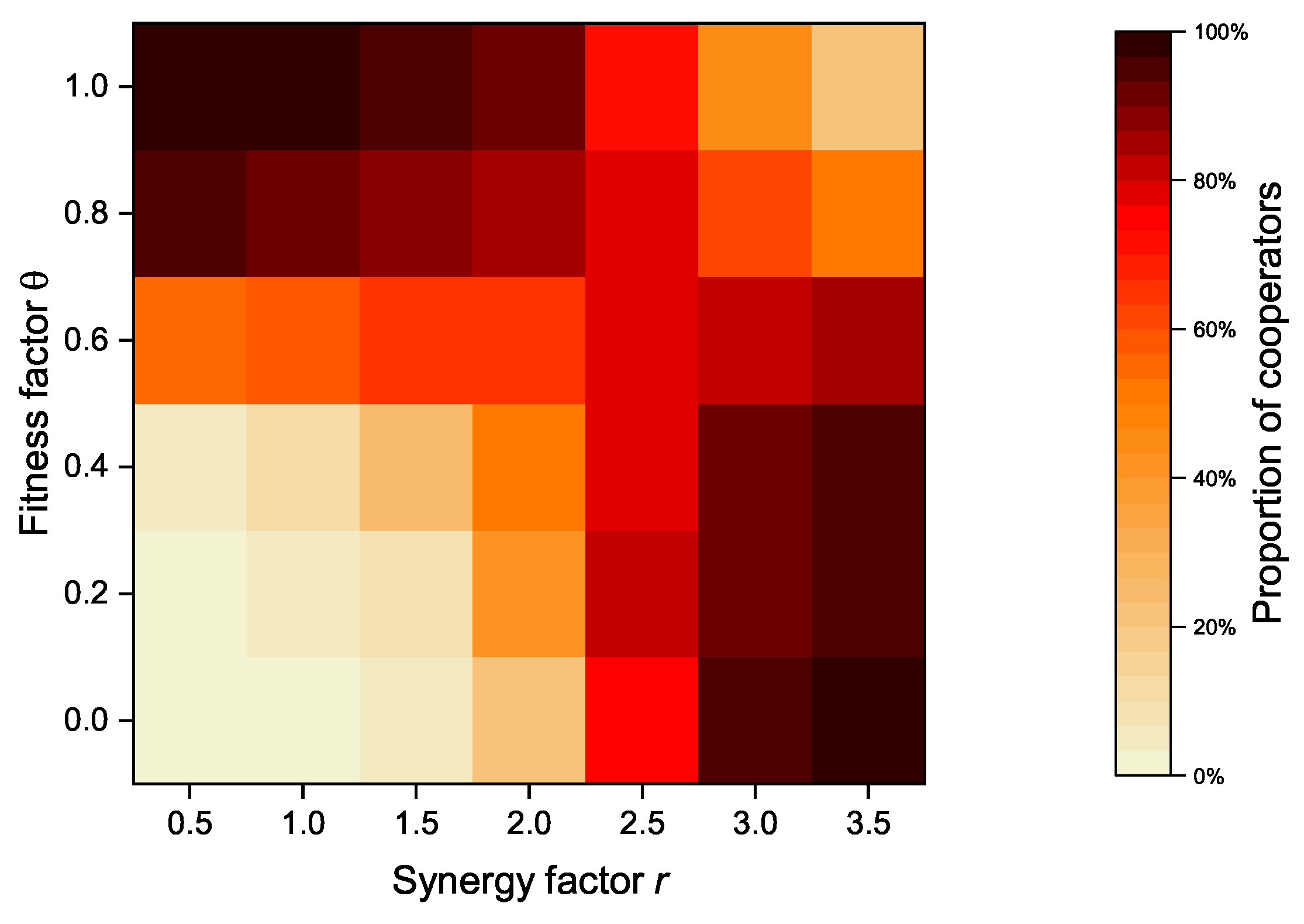
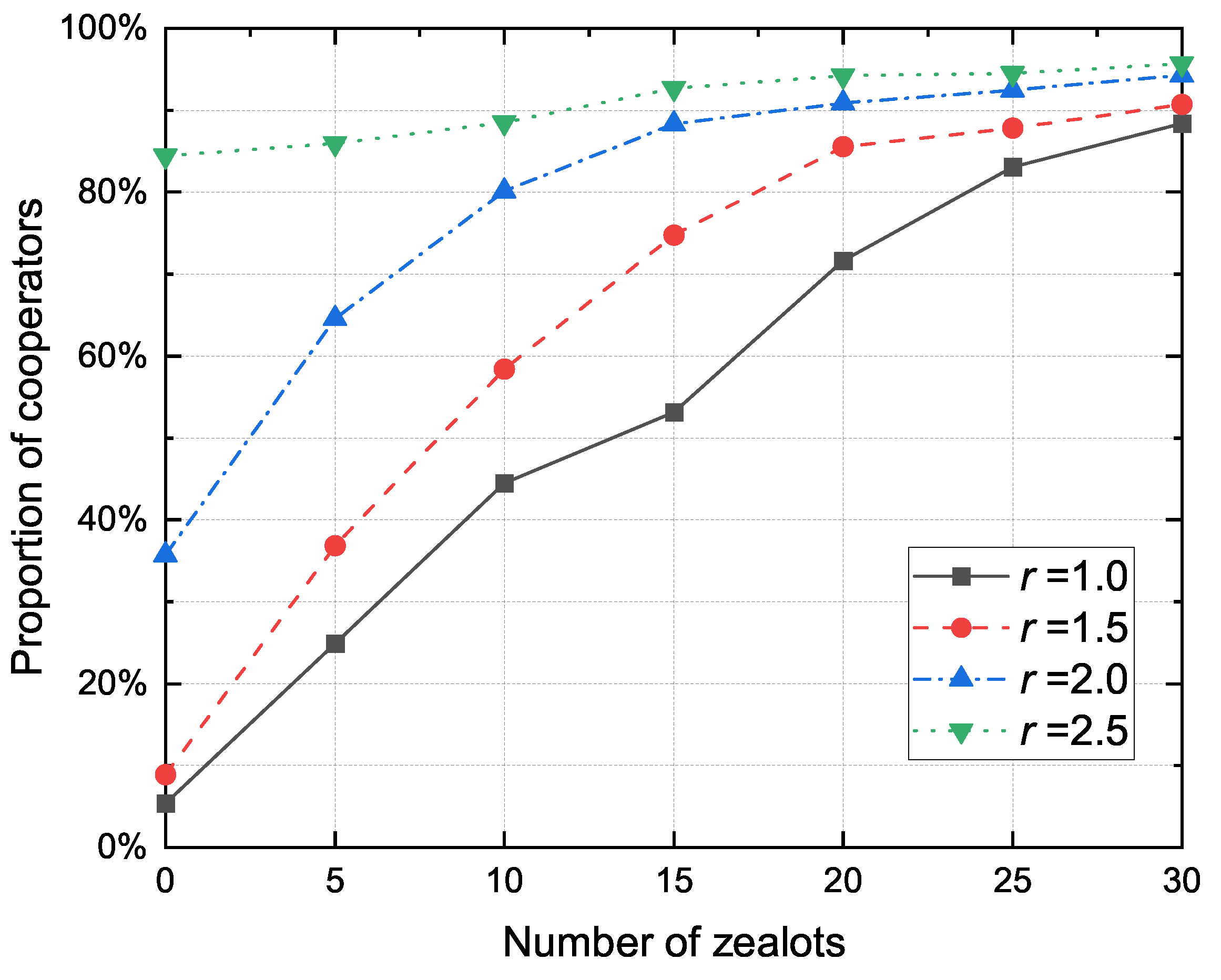
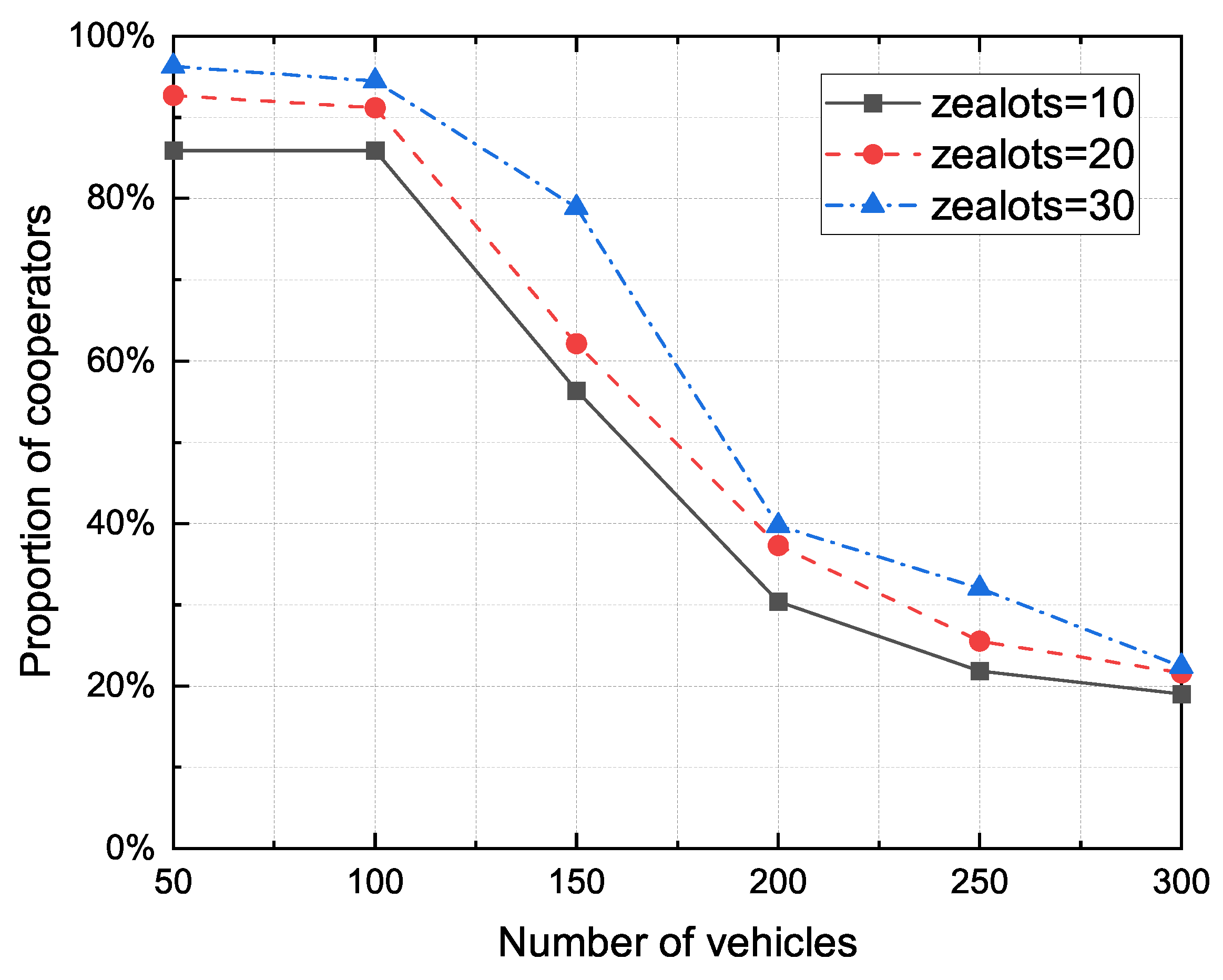
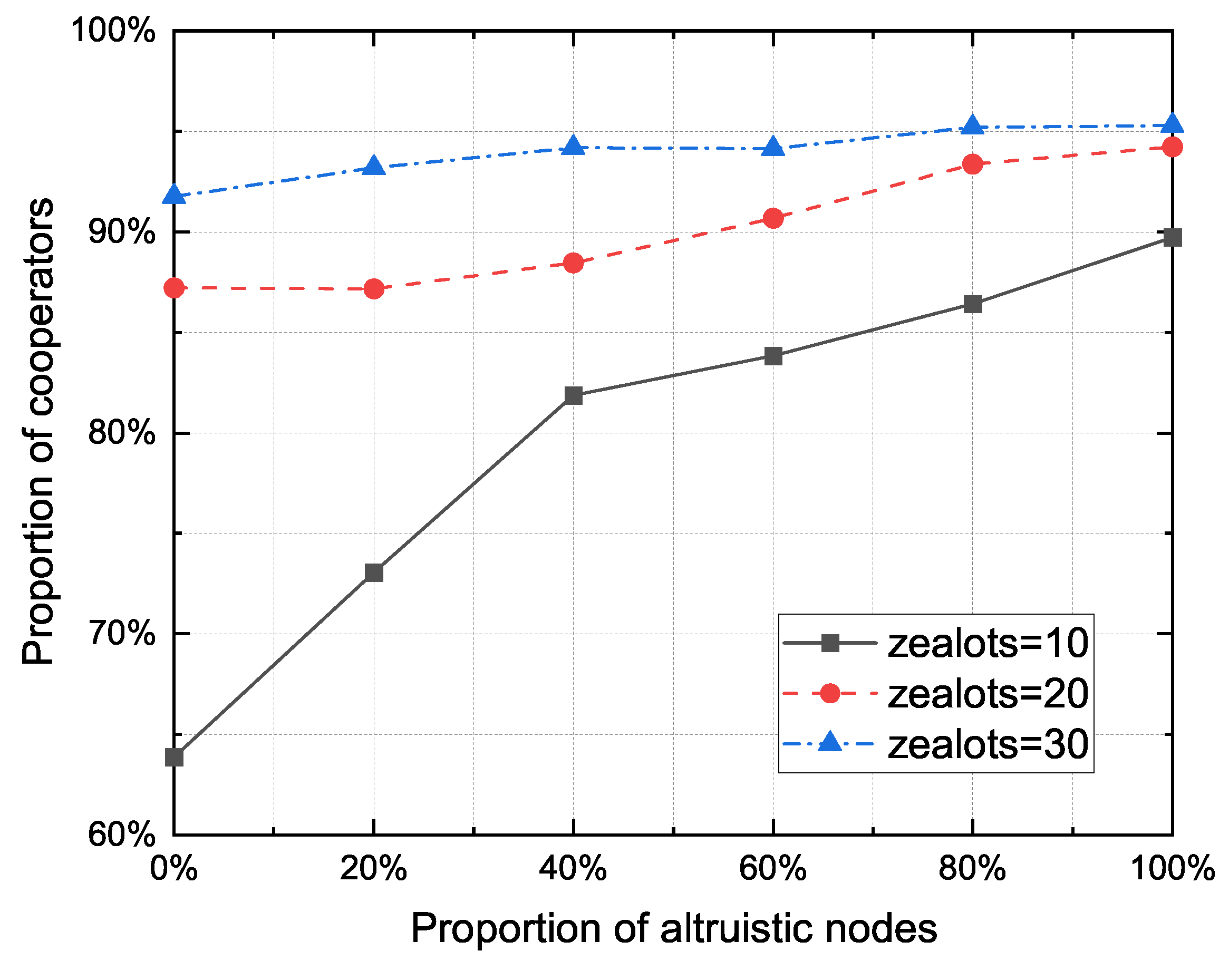
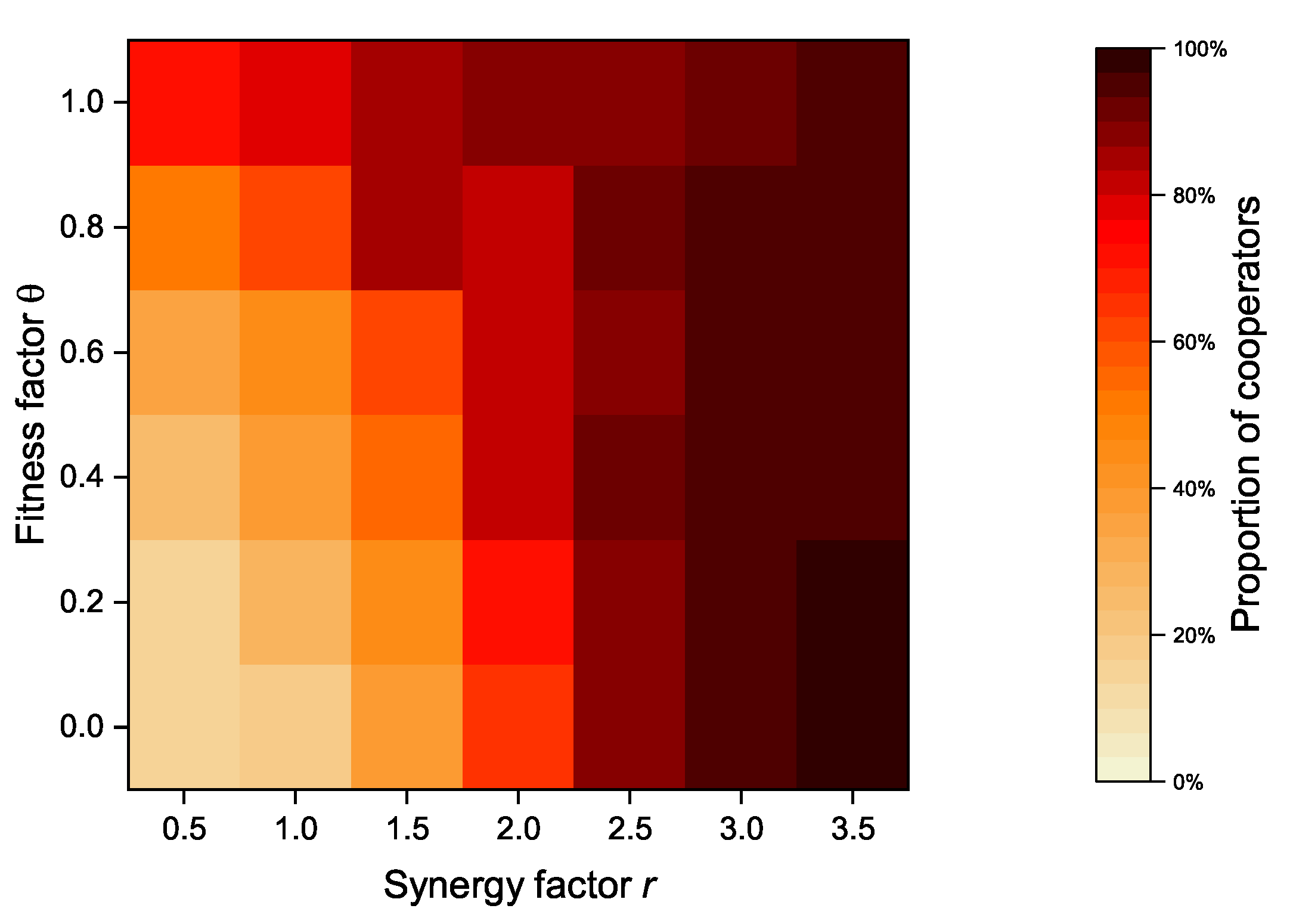
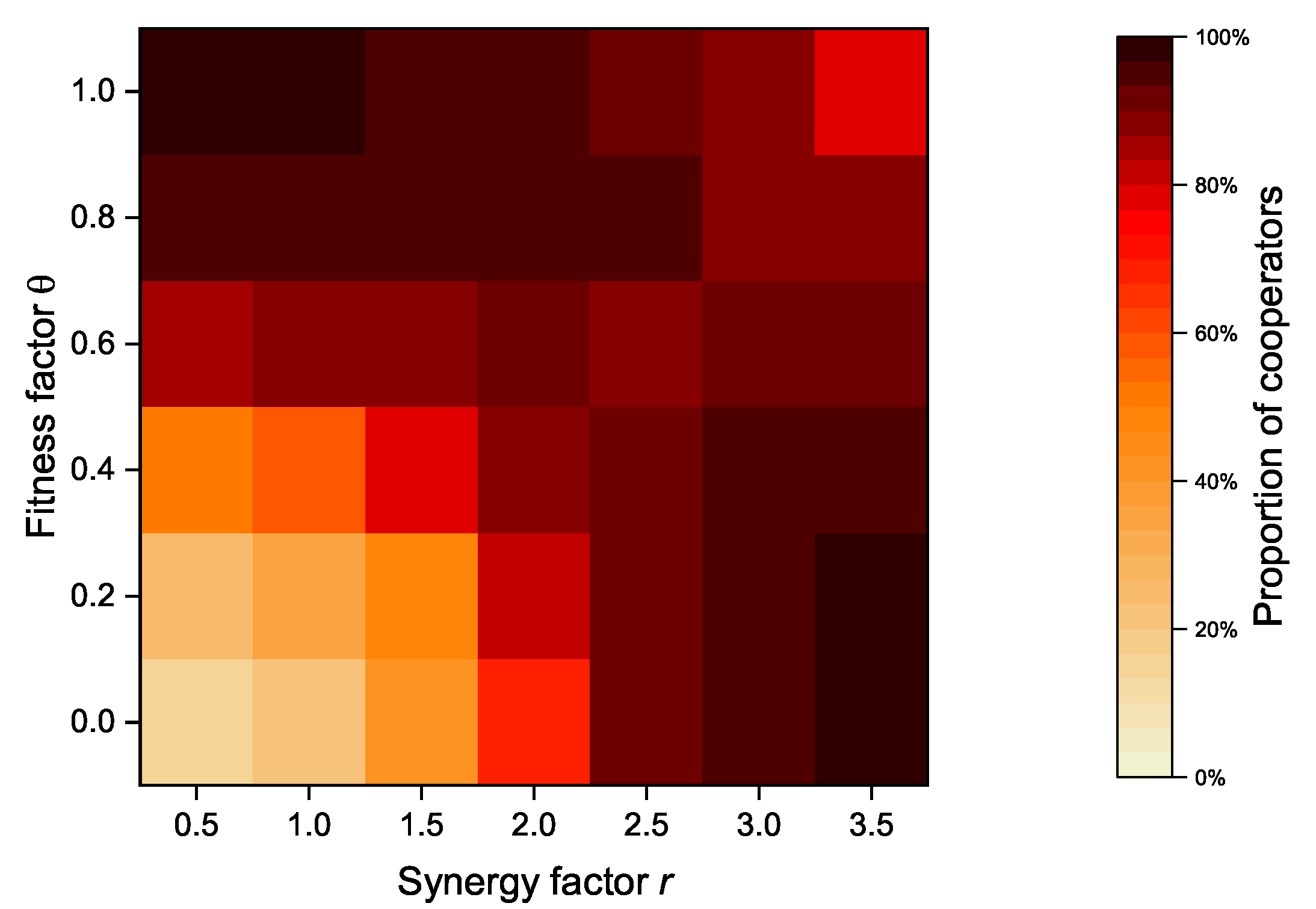
| Reference | Network | Game Model | Composition of Revenue | Application |
|---|---|---|---|---|
| [17] | Homogeneous | CG | Individual benefits | Message forwarding |
| [18] | Homogeneous | CG | Individual benefits | Advertisement distribution |
| [3] | Homogeneous | PGG | Individual benefits | Message dissemination |
| [4] | Homogeneous | PGG | Individual benefits | Group vehicular interaction |
| [9] | Homogeneous | PGG | Individual benefits | Content downloading |
| This paper | Heterogeneous | PGG | Individual, Neighborhood | Packet forwarding |
| Parameters | Values |
|---|---|
| Number of vehicles | [50, 100, 200] |
| Simulation map size | 1000 m × 1000 m |
| Simulation time | 800 s |
| Max velocity | 20 m/s |
| Acceleration | 1.0 m/s |
| Deceleration | 3.0 m/s |
| Acceleration exponent | 4 |
| Desired time headway | 1.5 |
| Minimum gap | 2 |
| 50 m | |
| 100 m |
© 2020 by the authors. Licensee MDPI, Basel, Switzerland. This article is an open access article distributed under the terms and conditions of the Creative Commons Attribution (CC BY) license (http://creativecommons.org/licenses/by/4.0/).
Share and Cite
Wang, Q.; Liu, H.; Jin, X.; Wang, Z. A Heterogeneous Network Modeling Method Based on Public Goods Game Theory to Explore Cooperative Behavior in VANETs. Sensors 2020, 20, 1802. https://doi.org/10.3390/s20061802
Wang Q, Liu H, Jin X, Wang Z. A Heterogeneous Network Modeling Method Based on Public Goods Game Theory to Explore Cooperative Behavior in VANETs. Sensors. 2020; 20(6):1802. https://doi.org/10.3390/s20061802
Chicago/Turabian StyleWang, Qiuhua, Hao Liu, Xing Jin, and Zhen Wang. 2020. "A Heterogeneous Network Modeling Method Based on Public Goods Game Theory to Explore Cooperative Behavior in VANETs" Sensors 20, no. 6: 1802. https://doi.org/10.3390/s20061802
APA StyleWang, Q., Liu, H., Jin, X., & Wang, Z. (2020). A Heterogeneous Network Modeling Method Based on Public Goods Game Theory to Explore Cooperative Behavior in VANETs. Sensors, 20(6), 1802. https://doi.org/10.3390/s20061802





